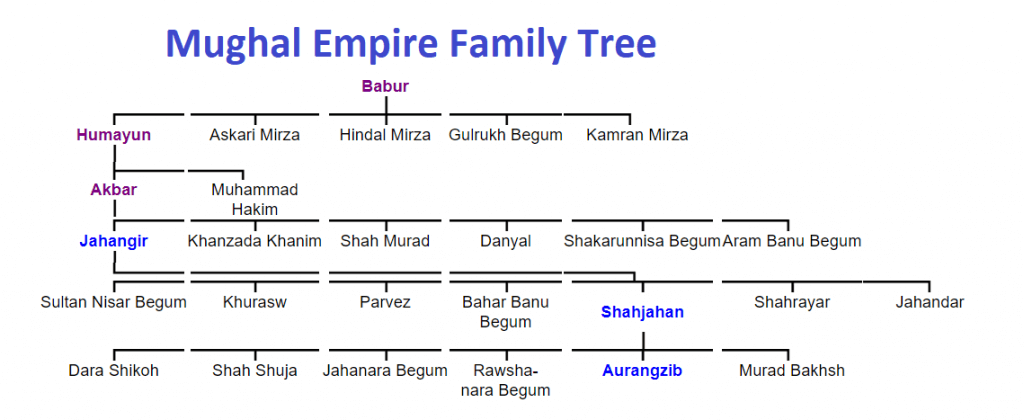List of Mughal Emperors in India (1526–1857) PDF: Check Complete Timeline and Family Tree
Oct 10 2025
The Mughal Empire in India (1526–1857) stands as one of the most influential and powerful dynasties in Indian history. Founded by Babur after his victory in the First Battle of Panipat (1526), the Mughal rule introduced remarkable advancements in art, architecture, administration, and culture. The dynasty, also known as the House of Babur or Gurkanis, saw great emperors like Akbar, Jahangir, Shah Jahan, and Aurangzeb, whose reigns shaped the political and cultural fabric of India.
This article provides the complete list of Mughal Emperors in India in chronological order, along with their period of rule, major achievements, and historical significance. It also includes the Mughal Empire Family Tree, which illustrates the royal lineage from Babur to Bahadur Shah II, the last Mughal Emperor exiled after the Revolt of 1857.
For aspirants preparing for UPSC, SSC, Banking, Railways, or other government exams, this detailed timeline of Mughal rulers will help strengthen their Indian History and Static GK preparation. You can also download the List of Mughal Emperors in India PDF in both English and Hindi for quick revision.
List Of Mughal Emperors in India PDF In English
List Of Mughal Emperors in India PDF In Hindi
Dynasty of the Mughal
The Mughal Dynasty comprised the members of the imperial House of Babur, also known as the Gurkanis, who ruled the Mughal Empire from 1526 to 1857.
-
After Babur, his son came into power and followed the Family Tree of the Mughal Empire.
-
This is how the Mughal Dynasty started in India, and after the rule of Aurangzeb, it started to decline.
List of all Governor Generals in India
Mughal Empire Family Tree
The family tree of the Mughal Empire is a flow chart that shows the Mughal emperor's family. The family of Mughal emperors consists of 20 members who have ruled the Indian subcontinent, which also consists of Bangladesh, Pakistan, and Afghanistan.

Download the List of Static GK
List of National Parks In India
Chronological Order of the List of Mughal Emperors of the Mughal Empire in India Timeline
The table below will give a clear idea about the chronological order of the list of Mughal emperors of the Mughal Empire in India's timeline.
List Of Mughal Emperors In Order Of Years |
||
Mughal Empire Kings |
Period Of Ruling |
Description |
|
Babur |
1526–1530 |
He was the founder of the Mughal Empire after his victories at the Battle of Panipat (1526) and the Battle of Khanwa. |
|
Humayun |
I- 1530–1540
II – 1555–1556 |
The rule was interrupted by the Suri Dynasty. Being young and inexperienced led him to be regarded as a less effective ruler than Sher Shah Suri, who defeated him and established the Suri Dynasty.
The restored rule was more unified and effective than the initial reign of 1530–1540. He left the unified empire to his son, Akbar. |
|
Akbar was one of the youngest rulers. He became a ruler at the age of 13. |
1556–1605 |
He and Bairam Khan defeated Hemu during the Second Battle of Panipat and later won famous victories during the Siege of Chittorgarh and the Siege of Ranthambore. One of his most famous construction marvels was the Lahore Fort. He abolished the Jizyah tax imposed on Hindus. To learn more about Akbar’s successors, check the article linked. |
|
Jahangir |
1605–1627 |
Opened relations with the British East India Company. |
|
Shah Jahan |
1628–1658 |
Born on 5th January 1592. Under him, Mughal art and architecture reached their zenith. He constructed the Taj Mahal, Jama Masjid, Red Fort, Jahangir mausoleum, and Shalimar Gardens in Lahore. Died in the captivity of his son Aurangzeb. |
|
Aurangzeb |
1658–1707 |
He ascended the throne on 31st July 1658. He reinterpreted Islamic law and presented the Fatawa-e-Alamgiri. He captured the diamond mines of the Sultanate of Golconda, spent the major part of his last 27 years in the war with the Maratha rebels, and expanded the empire to its greatest extent. |
|
Bahadur Shah I (also known as Muazzam/Shah Alam I) |
1707–1712 |
After his reign, the empire went into a steady decline due to the lack of leadership qualities among his immediate successors. He released Shahuji, the Son of Shambuji, who was the elder son of Shivaji. |
|
Jahandar Shah |
1712–1713 |
He was an unpopular, incompetent titular figurehead. |
|
Furrukhsiyar |
1713–1719 |
His reign marked the ascendancy of the manipulative Syed Brothers and the execution of the rebel Banda. In 1717, he granted a Firman to the English East India Company, granting them duty-free trading rights for Bengal. The Firman was repudiated by the notable Murshid Quli Khan. |
|
Rafi Ul-Darjat |
1719 |
The 10th Mughal Emperor. He succeeded Furrukhsiyar, being proclaimed Badshah by the Syed Brothers. |
|
Rafi Ud-Daulat |
1719 |
He was the Mughal emperor for a brief period in 1719. |
|
Muhammad Ibrahim (Claimant to the throne) |
1720 |
Brother of Rafi Ul-Darjat
Attempted to seize the throne at the behest of the Syed Brothers to depose Emperor Muhammad Shah |
|
Muhammad Shah (also called Rangeela) |
1719–1720
1720–1748 |
Got rid of the Syed Brothers. Counterred the emergence of the renegade Marathas and lost large tracts of the Deccan and Malwa in the process. Suffered the invasion of Nadir-Shah of Persia in 1739. |
|
Ahmad Shah Bahadur |
1748–1754 |
Son of Muhammad Shah. His Minister Safdarjung was responsible for the Mughal Civil War. He was defeated at Sikandarabad by the Maratha Confederacy. |
|
Alamgir II |
1754–1759 |
He was murdered by a conspiracy of Imad-Ul-Mulk and his Maratha associate Sadashivrao Bhau. |
|
Shah Jahan III |
1759-1760 |
He was overthrown after the Third Battle of Panipat by Prince Mirza Jawan Bakht. |
|
Shah Alam II |
1760–1806 |
He is known to have fought against the British East India Company during the Battle of Buxar and reformed the Mughal Army under the command of Mirza Naja. Khan. He is thus known as one of the last effective Mughal Emperors. |
|
Akbar Shah II |
1806–1837 |
He designated Mir Fateh Ali Khan Talpur as the new Nawab of Sindh. Although he was under British protection, his imperial name was removed from the official coinage after a brief dispute with the British East India Company. |
|
Bahadur Shah II |
1837–1857 |
He was the last Mughal Emperor. He was deposed by the British and exiled to Burma following the Indian Rebellion of 1857. |
Access Free Current Affairs PDFs
List of Mughal Emperors In Order In Hindi
The list of Mughal Emperors is given in order in the Hindi language
मुगल बादशाहों की सूची वर्षों के क्रम में |
||
सम्राट का नाम |
शासन की अवधि |
विवरण |
|
बाबर |
1526–1530 |
पानीपत की लड़ाई (1526) और खानवा की लड़ाई में अपनी जीत के बाद मुगल साम्राज्य के संस्थापक थे। |
|
हुमायूं |
I- 1530–1540
II – 1555–1556 |
शासन सूरी राजवंश द्वारा बाधित किया गया था। युवा और अनुभवहीन होने के कारण उन्हें शेर शाह सूरी की तुलना में कम प्रभावी शासक माना जाने लगा, जिन्होंने उन्हें हराया और सूरी राजवंश की स्थापना की।
1530-1540 के प्रारंभिक शासनकाल की तुलना में पुनर्स्थापित नियम अधिक एकीकृत और प्रभावी था। उन्होंने एकीकृत साम्राज्य अपने पुत्र अकबर के लिए छोड़ दिया। |
|
अकबर (सबसे कम उम्र के शासकों में से एक थे। 13 वर्ष की आयु में शासक बने) |
1556-1605 |
उन्होंने और बैरम खान ने पानीपत की दूसरी लड़ाई के दौरान हेमू को हराया और बाद में चित्तौड़गढ़ की घेराबंदी और रणथंभौर की घेराबंदी के दौरान प्रसिद्ध जीत हासिल की। उनके सबसे प्रसिद्ध निर्माण चमत्कारों में से एक लाहौर का किला था। उन्होंने हिंदुओं पर लगाए गए जजिया कर को समाप्त कर दिया।
अकबर के उत्तराधिकारियों के बारे में अधिक जानने के लिए, जुड़े लेख को देखें। |
|
जहांगीर |
1605-1627 |
ब्रिटिश ईस्ट इंडिया कंपनी के साथ संबंध खोले। |
|
शाहजहाँ |
1628-1658 |
5 जनवरी 1592 को जन्म।
उसके अधीन, मुगल कला और वास्तुकला अपने चरम पर पहुंच गई। उन्होंने लाहौर में ताजमहल, जामा मस्जिद, लाल किला, जहांगीर मकबरा और शालीमार गार्डन बनवाया। अपने बेटे औरंगजेब की कैद में मर गया। |
|
औरंगजेब |
1658-1707 |
वह 31 जुलाई 1658 को सिंहासन पर बैठा।
उन्होंने इस्लामी कानून की पुनर्व्याख्या की और फतवा -ए- आलमगीरी पेश की । उसने गोलकुंडा की सल्तनत की हीरे की खदानों पर कब्जा कर लिया और अपने अंतिम 27 वर्षों के प्रमुख भाग को मराठा विद्रोहियों के साथ युद्ध में बिताया और साम्राज्य को अपनी सबसे बड़ी सीमा तक विस्तारित किया। |
|
बहादुर शाह I ( मुअज्जम / शाह आलम I के नाम से भी जाना जाता है) |
1707-1712 |
उनके शासनकाल के बाद, उनके तत्काल उत्तराधिकारियों के बीच नेतृत्व के गुणों की कमी के कारण साम्राज्य लगातार गिरावट में चला गया। उन्होंने शंभूजी के पुत्र शाहूजी को रिहा कर दिया, जो शिवाजी के बड़े पुत्र थे । |
|
जहांदार शाह |
1712–1713 |
एक अलोकप्रिय अक्षम नाममात्र का व्यक्ति था। |
|
फारुखसियर (Farrukhsiyar) |
1713-1719 |
सैयद बंधुओं का प्रभुत्व और विद्रोही बंदा को मृत्युदंड दिया गया। 1717 में उन्होंने अंग्रेजी ईस्ट इंडिया कंपनी को बंगाल के लिए शुल्क मुक्त व्यापार अधिकार प्रदान करने के लिए एक फ़रमान प्रदान किया। उल्लेखनीय मुर्शिद कुली खान द्वारा फ़रमान का खंडन किया गया था। |
|
रफी उल-दरजात |
1719 |
10वें मुगल बादशाह थे। सैयद भाईयों द्वारा बादशाह घोषित किए जाने के कारण, उन्होंने फुरुखसियर का स्थान लिया। |
|
रफी उद-दौलत |
1719 |
1719 में एक संक्षिप्त अवधि के लिए मुग़ल सम्राट थे । |
|
मुहम्मद इब्राहिम (सिंहासन के दावेदार) |
1720 |
रफ़ी के भाई उल-दरजात
बादशाह मुहम्मद शाह को अपदस्थ करने के लिए सैयद बंधुओं के इशारे पर गद्दी हथियाने का प्रयास किया |
|
मुहम्मद शाह ( रंगीला भी कहा जाता है ) |
1719–1720
1720–1748 |
सैयद बंधुओं से छुटकारा मिला । पाखण्डी मराठों के उदय का मुकाबला किया और इस प्रक्रिया में दक्कन और मालवा के बड़े इलाकों को खो दिया। 1739 में फारस के नादिर-शाह के आक्रमण का सामना करना पड़ा। |
|
अहमद शाह बहादुर |
1748-1754 |
मुहम्मद शाह के पुत्र। उसका मंत्री सफदरजंग मुगल गृहयुद्ध के लिए उत्तरदायी था । वह सिकंदराबाद में मराठा परिसंघ द्वारा पराजित हुआ था। |
|
आलमगीर II |
1754–1759 |
उनकी हत्या इमाद-उल-मुल्क और उनके मराठा सहयोगी सदाशिवराव भाऊ की साजिश से हुई थी |
|
शाहजहाँ III |
1759-1760 |
पानीपत की तीसरी लड़ाई के बाद राजकुमार मिर्जा जवान बख्त द्वारा उन्हें उखाड़ फेंका गया था। |
|
शाह आलम II |
1760-1806 |
बक्सर की लड़ाई के दौरान ब्रिटिश ईस्ट इंडिया कंपनी के खिलाफ लड़ने और मिर्जा नजफ खान की कमान में मुगल सेना में सुधार करने के लिए जाना जाता है, इस प्रकार उन्हें अंतिम प्रभावी मुगल सम्राटों में से एक के रूप में जाना जाता है। |
|
अकबर शाह II |
1806-1837 |
उन्होंने मीर फतेह अली खान तालपुर को सिंध के नए नवाब के रूप में नामित किया । हालांकि वह ब्रिटिश संरक्षण में थे, ब्रिटिश ईस्ट इंडिया कंपनी के साथ एक संक्षिप्त विवाद के बाद उनके शाही नाम को आधिकारिक सिक्के से हटा दिया गया था। |
|
बहादुर शाह II |
1837-1857 |
वह अंतिम मुगल सम्राट थे। 1857 के भारतीय विद्रोह के बाद उन्हें अंग्रेजों द्वारा पदच्युत कर दिया गया और बर्मा में निर्वासित कर दिया गया। |
Wildlife Sanctuaries in India
List Of Mughal Emperors FAQs
Q: Who is the first emperor in the list of Mughal emperors in India?
A: Babur was the first emperor in the list of Mughal Emperors in India.
Q: Mughal Empire Family Tree is also called?
A: The Mughal Empire Family Tree is also called the Family Tree of the Mughal Empire, Mughal Family Tree, and Family Tree Mughal Empire.
Q: When did the Mughal Empire start in India?
A: From the period of 1526 Mughal Empire started in India.
Q: Who was the youngest Mughal Emperor in India?
A: Akbar was the youngest Mughal Emperor in India.
Q: Who Constructed the Taj Mahal?
A: Shah Jahan was the Mughal emperor who constructed the Taj Mahal in remembrance of his wife Mumtaj.
Q: Who was the last emperor in India's list of Mughal emperors?
A: Bahadur Shah II was the last Mughal Emperor in India
Q: Who opened a relationship with the British East India Company?
A: The Mughal Emperor Jahangir opened a relationship with the British East India Company.
Q: Is the List of Mughal Emperors PDF available in bilingual languages?
A: The List of Mughal Emperors PDF is available in English and Hindi.
Q: How many Mughal Emperors ruled India?
A: There are 21 Mughal Emperors who ruled India.
Q: How many Mughal Emperors were there?
A: There were a total of 21 Mughal Emperors.
General Awareness Smart Analysis (Smart Quiz 2.0)
- Get Weekly 4 set Test
- Each Set consist of 50 Questions
- Compare your progress with Test 1 & 2 & Test 3 & 4
- Deep Analysis in topic wise questions
Super Plan
- Bundle PDF Course 2025
- Premium Bundle PDF Course 2024
- Bundle PDF Course 2023
- Ultimate Bundle PDF Course 2022
- English Bundle PDF Course
- Insurance & Financial Market Awareness Bundle PDF Course
- Descriptive Papers for Bank & Insurance Exams
- Interview Bundle PDF Course
- General Awareness Smart Analysis
- All Bank Exams Video Course*
- Platinum Package (Test Series)
- All Premium eBooks
- Interview Courses are not included*
Premium PDF Course
- Bundle PDF Course 2025
- Premium PDF Course 2024
- Prime PDF Course 2023







